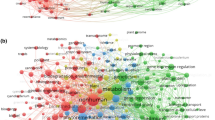Abstract
Plants have the ability to take up harmful substances and then store or metabolize them. This suggests the possibility of phytoremediation of soil contaminated with organic, inorganic, and radioactive substances, all of which are difficult to remove from soil with conventional methods. Phytoremediation is becoming an important tool for decontaminating soil, water, and air by detoxifying, extracting, hyperaccumulating, and/or sequestering contaminants, especially at low levels where, using current methods, costs exceed effectiveness. The genome of Arabidopsis thaliana has recently been sequenced and it has been shown that various of its genes can have an impact on its uptake of harmful substances. To identify and analyze all the genes that might be useful for phytoremediation is desirable because plants might then be engineered for faster and more precise phytoremediation. Here, a method is described for using real time-PCR to monitor gene expression in plants exposed to radioactivity. This method can monitor the expression of phytoremediationrelated genes under a variety of conditions. The experiments described here focus on DNA-repair genes and show how analyses can be extended to whole-genome studies of phytoremediation-related genes using DNA microarrays. A method to grow A. thaliana in hydroponic cultures is also outlined.
Access this chapter
Tax calculation will be finalised at checkout
Purchases are for personal use only
Similar content being viewed by others
References
Zhu, Y. G. and Shaw, G. (2000) Soil contamination with radionuclides and potential remediation. Chemosphere 41, 121–128.
Cunningham, S. D., Berti, W. R., and Huang, J. W. (1995) Phytoremediation of contaminated soils. Trends Biotechnol. 13, 393–397.
Cunningham, S. D. and Ow, D. W. (1996) Promises and prospects of phytoremediation, Plant Physiol. 110, 715–719.
Broadley, M. R. and Willey, N. J. (1997) Differences in root uptake of radiocaesium by 30 plant taxa, Environ. Pollut. 97, 11–15.
McGrath, S. P. and Zhao, F. J. (2003) Phytoextraction of metals and metalloids from contaminated soils. Curr. Opin. Biotechnol. 14, 277–282.
Assunção, A. G. L., da Costa Martins, P., de Folter, S., Vooijs, R., Schat, H., and Aarts, M. G. M. (2001) Elevated expression of metal transporter genes in three accessions of the metal hyperaccumulator Thlaspi caerulescens. Plant Cell Env. 24, 217–226.
Cobbett, C. S. and Meagher, R. B. (2002) Arabidopsis and the genetic potential for the phytoremediation of toxic elemental and organic pollutants. In: The Arabidopsis On-Line Textbook, (Somerville, C. R. and Meyerowitz, E. M., eds.), American Society of Plant Biologists, Rockville, MD, doi. 10.1199/tab. 0032.
Doucet-Chabeaud, G., Godon, C., Brutesco, C., de Murcia, G., and Kazmaier, M. (2001) Ionising radiation induces the expression of PARP-1 and PARP-2 genes in Arabidopsis. Mol. Genet. Genomics 265, 954–963.
West, C. E., Waterworth, W. M., Jiang, Q., and Bray, C. M. (2000) Arabidopsis DNA ligase IV is induced by gamma-irradiation and interacts with an Arabidopsis homologue of the double strand break repair protein XRCC4. Plant J. 24, 67–78.
Doutriaux, M. P., Couteau, F., Bergounioux, C., and White, C. (1998) Isolation and characterisation of the RAD51 and DMC1 homologs from Arabidopsis thaliana, Mol. Gen. Genomics 257, 283–291.
Deveaux, Y., Alonso, B., Pierrugues, O., Godon, C., and Kazmaier, M. (2000) Molecular cloning and developmental expression of AtGR1, a new growth-related Arabidopsis gene strongly induced by ionizing radiation. Radiat Res. 154, 355–364.
An, Y. Q., McDowell, J. M., Huang, S., McKinney, E. C., Chambliss, S., and Meagher, R. B. (1996) Strong, constitutive expression of the Arabidopsis ACT2/ACT8 actin subclass in vegetative tissues, Plant J. 10, 107–121.
Tocquin, P., Corbesier, L., Havelange, A., et al. (2003) A novel high efficiency, low maintenance, hydroponic system for synchronous growth and flowering of Arabidopsis thaliana, BMC Plant Biol. 30, 2.
Arteca, R. N. and Arteca, J. M. (2000) A novel method for growing Arabidopsis thaliana plants hydroponically. Physiol. Plant. 108, 188–193.
Pfaffl, M. W. (2001) A new mathematical model for relative quantification in realtime RT-PCR. Nucl. Acids. Res. 29, 2002–2007.
Acknowledgments
The work described here was supported by a bursary of the University of The West of England. John Hancock, Mrs. Judy Brown, and Mr Arthur Gough have given technical support and valuable advice.
Editor information
Editors and Affiliations
Rights and permissions
Copyright information
© 2007 Humana Press Inc., Totowa, NJ
About this protocol
Cite this protocol
Heinekamp, YJ., Willey, N. (2007). Using Real-Time Polymerase Chain Reaction to Quantify Gene Expression in Plants Exposed to Radioactivity. In: Willey, N. (eds) Phytoremediation. Methods in Biotechnology, vol 23. Humana Press. https://doi.org/10.1007/978-1-59745-098-0_5
Download citation
DOI: https://doi.org/10.1007/978-1-59745-098-0_5
Publisher Name: Humana Press
Print ISBN: 978-1-58829-541-5
Online ISBN: 978-1-59745-098-0
eBook Packages: Springer Protocols




